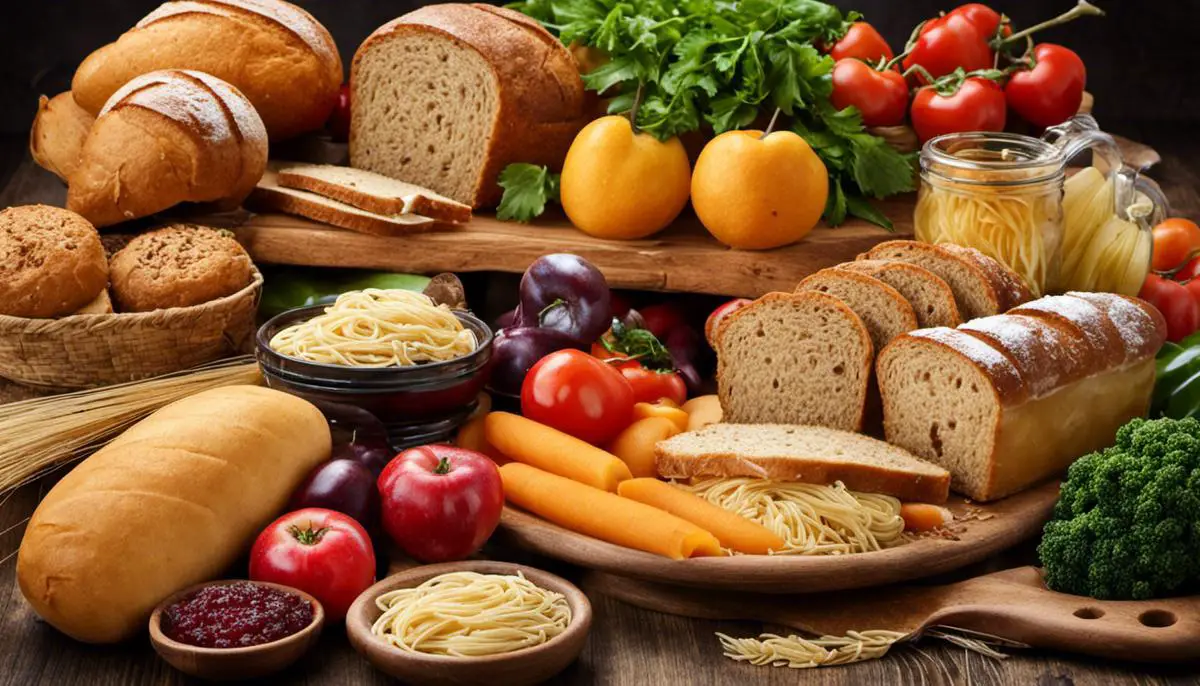When examining the diverse sphere of diet and nutrition, one finds a plethora of dietary patterns, each carved out to fit unique health needs and personal preferences. One such diet that has been garnering attention is the gluten-free diet. Shrouded in an atmosphere of ambiguity and curiosity, this diet goes far beyond being just another dietary trend. For those diagnosed with certain conditions, it’s not optional, but a crucial way of life. This dialogue ushers us into the intricate labyrinth of a gluten-free lifestyle, helping us understand its ins and outs, and equipping us with the requisite knowledge to maintain a balanced and healthful gluten-free diet if the need arises.
What is a Gluten-Free Diet?
What is a Gluten-Free Diet?
A gluten-free diet is a meal plan that doesn’t include any gluten, a protein composite found in grains like wheat, rye, and barley. This specific diet is essential for individuals diagnosed with celiac disease, a genetic autoimmune disorder where the intake of gluten damages the small intestine. People with non-celiac gluten sensitivity may also pursue a gluten-free diet as they may experience symptoms like bloating, stomach ache, or fatigue after consuming gluten.
Apart from health reasons, some people follow a gluten-free diet due to perceived health benefits. However, these benefits have not been scientifically validated, and a gluten-free diet may lack essential nutrients if not properly managed.
Why is a Gluten-Free Diet Necessary for Some Individuals?
Individuals diagnosed with celiac disease or non-celiac gluten sensitivity have an adverse reaction to gluten. For those with celiac disease, eating food containing gluten triggers an immune response that damages their small intestine’s lining, leading to malabsorption of nutrients, severe discomfort, and ultimately, various health complications. When gluten is eradicated from their diet, their gut can heal, and symptoms can be alleviated.
People with non-celiac gluten sensitivity don’t experience the same intestinal damage but can suffer from symptoms such as stomach cramps, diarrhea, and bloating when they consume gluten. Therefore, these individuals also benefit from a gluten-free diet.
Benefits and Pitfalls of a Gluten-Free Diet
While this diet is essential for people with celiac disease and non-celiac gluten sensitivity, it also poses some challenges. The benefits of a gluten-free diet include improved health and digestion, reduced chronic inflammation and autoimmune disorders, and increased energy levels.
However, there are also potential drawbacks. Gluten-free diets can lack essential nutrients, as many whole grains eliminated from this diet are significant sources of fiber, vitamins, and minerals. Gluten-free products often contain fewer nutrients and more added sugars and fats than their gluten-containing counterparts. Additionally, adhering to a gluten-free diet can be challenging and more expensive.
Misconceptions About Gluten-Free Diets
There are several misconceptions about a gluten-free diet, with the most common being that it’s inherently healthier. This is not necessarily true, as the benefits of a gluten-free diet primarily assist those with gluten-related disorders. In fact, without careful planning, a gluten-free diet can lack key nutrients. Another misconception is that gluten-free foods are weight-loss friendly. However, gluten-free does not mean low calorie or low fat. Many gluten-free products are high in sugar and fat to compensate for texture and flavor loss.
Gluten: Where It’s Found
Gluten is a protein typically found in wheat, barley, and rye, meaning it’s prevalent in a range of foods like bread, pastries, pasta, cereals, and beer. It’s also common in certain spreads and sauces. However, lesser-known sources of gluten also exist, such as in processed meats, ready-made meals, soups, and even certain beauty products. Becoming proficient at label-reading can help you easily spot these hidden sources of gluten.

Living with Celiac Disease and Non-Celiac Gluten Sensitivity
A Closer Look at Celiac Disease and Non-Celiac Gluten Sensitivity
Celiac disease is an autoimmune disorder that interferes with the small intestine’s ability to digest food properly. When someone with celiac disease ingests gluten, their immune system reacts, causing damage to the small intestine lining and hindering the absorption of crucial nutrients. Common symptoms of celiac disease encompass stomach pain, bloating, diarrhea, weight loss, and potential malnourishment over the long term.
Non-celiac gluten sensitivity, also known as gluten intolerance, shares similar symptoms with celiac disease. However, it does not cause the same level of intestinal damage, nor is it diagnosed using the same antibody and genetic testing characteristic of celiac disease. Symptoms might include bloating, stomach discomfort, and general fatigue.
Diagnosis of Celiac Disease and Non-Celiac Gluten Sensitivity
Diagnosis for both conditions involves a series of tests. For celiac disease, doctors often use a combination of antibody blood testing and intestinal biopsy. A positive blood test will usually be followed by a biopsy to assess damage in the small intestine. Genetic testing can also contribute to the diagnosis of celiac disease.
In the case of non-celiac gluten sensitivity, there are no recommended medical tests available. Diagnosis is often made through a process of exclusion. If both celiac disease and wheat allergy are ruled out, yet symptoms persist with gluten ingestion and improve on a gluten-free diet, a diagnosis of non-celiac gluten sensitivity may be reached.
Treatment: Role of a Gluten-Free Diet
The only proven treatment for celiac disease and non-celiac gluten sensitivity is a lifelong adherence to a strict gluten-free diet. Avoiding foods and ingredients that contain gluten can prevent damage to the small intestine in celiac patients and minimize symptoms in those with non-celiac gluten sensitivity.
Implementing a Gluten-Free Diet
Individuals requiring a gluten-free diet should focus on consuming naturally gluten-free foods such as fruits, vegetables, lean meats, poultry, fish, eggs, dairy products, nuts, and certain grains like rice, quinoa, and corn.
Many processed foods and other products—such as certain medications, cosmetics, and adhesive on envelopes—may contain hidden gluten, demanding patients vigilant in reading ingredient labels. Eating out also requires careful diligence, as cross-contamination with gluten-containing foods can occur.
When facing a diagnosis of celiac disease or non-celiac gluten sensitivity, consultation with a registered dietitian knowledgeable in these conditions can guide individuals through the process of transitioning to a gluten-free diet while maintaining a balanced, nutritious eating plan. Online resources and support groups can be beneficial for finding gluten-free recipes and addressing common challenges when living with these conditions.
A host of strategies have been identified that can help individuals suffering from celiac disease or non-celiac gluten sensitivity. By maintaining a strict consensus to a gluten-free diet, they can efficiently control their symptoms and boost gut health.

How to Maintain a Balanced Gluten-Free Diet
Taking a Deeper Look at Gluten and Gluten-Free Diets
A gluten-free diet is crucial for people with celiac disease, an auto-immune disorder that causes inflammation and damage in the small intestine upon consumption of gluten. However, many others choose to adopt a gluten-free lifestyle either due to a sensitivity towards gluten or as a part of a conscious health benefit decision.
Naturally Gluten-Free Foods
Gluten is a type of protein found in rye, barley, and wheat, including all wheat varieties like durum, semolina, and spelled. Foods containing these grains have to be avoided on a gluten-free diet.
Naturally gluten-free foods include fruits, vegetables, meat and poultry, fish and seafood, dairy, beans, legumes, and nuts. Also, several grains are naturally gluten-free, including rice, corn (maize), soy, potato, tapioca, beans, millet, buckwheat, quinoa, teff, sorghum, and amaranth.
However, while these foods are inherently gluten-free, be cautious of various forms, such as cold cuts or pre-packaged versions which could contain gluten.
Avoiding Nutrient Deficiencies
Despite the numerous food options available on a gluten-free diet, there is a possibility of nutrient deficiencies. Some of the nutrients that could potentially be missed out on due to a lack of wheat in the diet include B vitamins, folic acid, and iron.
To compensate, you might consider incorporating foods that are gluten-free and high in those nutrients, such as lean meats, beans, fortified gluten-free grains, fruits, and vegetables.
Minimizing Cross-Contamination
Cross-contamination can occur when gluten-free foods come into contact with foods containing gluten. It can happen through shared utensils, toasters, or bulk food bins. It can also occur in manufacturing plants if the same machinery is used for gluten and non-gluten products.
To avoid this, use separate cooking and baking equipment for gluten-free foods, or thoroughly clean shared utensils and surfaces. When shopping, choose products specifically labeled gluten-free that are less likely to have suffered contamination during production.
Reading Food Labels
Unfortunately, gluten is often hidden in various foods, making label-reading a crucial skill. It might be listed as hydrolyzed vegetable protein, texturized vegetable protein, modified food starch, or malt flavoring.
In a lot of countries, labeling laws require allergens like wheat to be listed on food labels. However, barley and rye aren’t always listed. Hence, it’s critical to understand the sources of these grains and familiarize yourself with label-reading skills to ensure food safety.
Remember that “wheat-free” doesn’t imply “gluten-free”. It may still contain rye and barley. Always look for labels stating “gluten-free”.
By understanding what foods to include, using precautions to avoid cross-contamination and awareness of label-reading, you can successfully maintain a balanced, nutritious, gluten-free diet without risking deficiencies. It’s also recommended to seek advice from dietitians to tailor your meals according to your nutritional needs.

A shift into a gluten-free lifestyle requires thoughtful navigation through dietary choices and a clear understanding of what it entails. As this exploration of celiac disease, non-celiac gluten sensitivity, and the role of a gluten-free diet in these conditions illustrates, it is possible to adopt and manage a balanced gluten-free life. Embracing this lifestyle involves reading food labels meticulously, knowing what foods are naturally gluten-free, making sure to get all necessary nutrients, and being vigilant about avoiding cross-contamination. With the right information at hand, one can affirm that living gluten-free can be a path to improved health and overall wellness without nutritional compromise.
